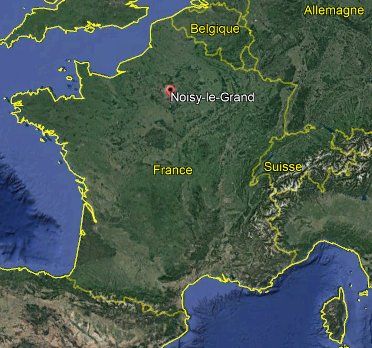
The index page for the 1954 French flap section of this website is here.
Reference for this case: 16-Oct-54-Noisy-le-Grand.
Please cite this reference in any correspondence with me regarding this case.
In 1956, the pioneer ufologist Aimé Michel published an article in a US ufology bulletin in which he notably mentioned observations in France on the evening of October 16, 1954.
One of the sightings was said to have taken place in Noisy-le-Grand, in the Seine-Saint-Denis department. Michel gave no source and no detail, indicating only that it occurred, like in Paris, at 9:35 p.m., and that in Chelles the trajectory of the object was seen from the side.
In the article, Michel indicated that the "Commission of Investigation of the French Air Force" had explained that it was a slow meteor; Michel refused the explanation, arguing that the commission would not have taken into account a "change of direction" during the last observation of the series, arguing that the time of the first and last observation shows that the thing was only flying at 3,000 km/h, too slow for a meteor, and denying that the witnesses' watches could have been imprecisely set.
In his 1958 book "Flying Saucers and the Straight Line Mystery", however, he had changed his mind. Without reviewing his previous arguments, he presented the series of sightings as that of a meteor, and explained that what we can learn from the reports is that although some witnesses called the object a "flying saucer", all had correctly described a meteor.
[Ref. aml7:] AIME MICHEL:
[... other cases...]
The object [seen over France on the night of October 16, 1954] arrived shortly above Paris where, at 9:35, it was reported over the great Orly airport (all operations ceasing for several minutes), and, simultaneously, from both sides of the trajectory, at Chelle, Nanterre and Noisy-le-Grand.
Witnesses under the trajectory called it a disk. Those to either side insisted on a cigar-shaped object. [... other cases...]
[... other cases...]
The French Air Force Inquiry Commission, after studying the case [of the October 16, 1954 sightings in the night], concluded that the object was a "slow meteor." The Commission did not take into account the change of direction of the last Paris sighting. To the several witnesses who saw the UFO halt in the sky, the Commission answered: "Optical Illusion," and since this time differentials reported suggested a meteor traveling at an impossibly slow speed (2400 miles per hour), the Commission supposed that the witnesses' watches had broken.
[... other cases...]
[Ref. aml1:] AIME MICHEL:
Aimé Michel wrote about the October 16, 1954, 09:30 p.m. meteor:
THE TEST OF THE METEOR. October 16, as if it was purposely, a splendid meteor crossed the north of France towards 09:30 p.m.. It was observed on a score of departments by thousands of people, from the Allier to Lorraine and from the Swiss border to Paris. Naturally many witnesses believed to have seen a Flying Saucer and said so. The newspapers printed "Flying Saucer in Orly", or "in Montididier", or "in Metz." But once again the description made by all these weak brains appeared of a remarkable honesty.
[...]
The innumerable gathered testimonys show indeed that even when the witnesses called "Flying saucer" the observed object, their description is identical on 200.000 square kilometres where the visible phenomenon was visible: an "orange ball followed by a trail", a "large luminous ball with a tail", a "flying egg followed by a trail", a "bottle's bottom with a trail of thirty times its diameter", etc. The same phenomenon is uniformly described.
[...]

|
The meteor of October 16, 1954, at 09:30 p.m..
Aimé Michel's arguments in his 1956 article are not valid:
Around 9:30 p.m., what passed in the sky was described by witnesses as having the appearance of a meteor, as Michel understands it two years later.
His too slow speed argument consisted in taking the first hour and the last hour given in this series of observations, to imagine that the first hour is at the beginning of the seen trajectory and the last at the end, to imagine that these hours are precise to the minute. It was the Air Force that was right - except that I doubt that they said that the witnesses' watches "broke" as Michel said, I think they rather considered them to be sometimes not precisely set.
The argument based on the hours presented in 1956 by Aimé Michel is as erroneous as that of another pioneer of ufology, Charles Garreau, whom Michel knew. In 1958, Michel undoubtedly realized that it made no sense, and he gave up this argument. Garreau on his side never renounced to this error.
(These keywords are only to help queries and are not implying anything.)
Noisy-le-Grand, Seine-Saint-Denis, night
[----] indicates sources that are not yet available to me.
| Version: | Created/Changed by: | Date: | Change Description: |
|---|---|---|---|
| 1.0 | Patrick Gross | February 24, 2021 | First published. |